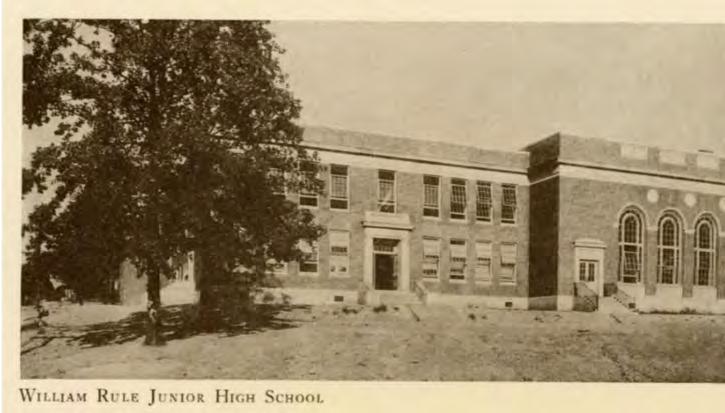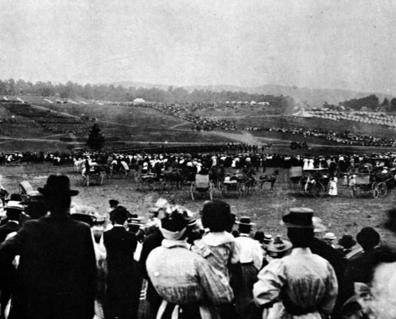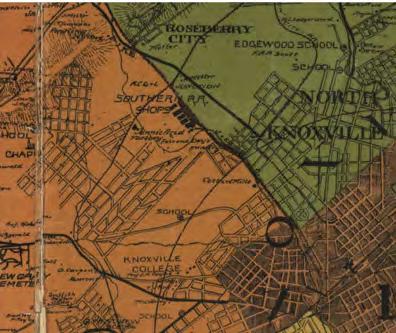
6 minute read
Western Heights Neighborhood History

Advertisement
Written by: Knoxville History Project & KCDC
Where you live affects your entire life: your health, your educational opportunities, your job prospects, your earning potential, and your overall happiness.
Place-based transformation defines a geographic region; works within a community’s current infrastructure; engages the support, expertise, and technical assistance of local, state, and national partners; and establishes and builds on existing community-driven leadership and ownership to achieve neighborhood transformation. We are working with the residents of the Beaumont and Western Heights neighborhoods to ignite placebased transformation in their community. We are doing this through a collective impact approach and engaging the residents and community service providers to work together to identify needs and bring their voices and visions for transforming their community. By aligning existing community assets and addressing multiple factors influencing generational poverty, we are creating a sustainable culture and framework for lifting an entire community.
The Beaumont and Western Heights neighborhoods feature a special artistic heritage and echo a past connected to the Liberal Arts. The area also played childhood muse and inspiration to such famous international figures as Frances Hodgson Burnett, David Madden, and Clarence Brown.
Beaumont is French for “lovely hill,” describing the hillside community with picture-perfect views of downtown. Mainly rural throughout the 19th century, it was near the site of a Confederate encampment during the two-week Siege of Knoxville in November 1863. Months after the war, the Hodgson family moved to the hilltop that later became the campus of Knoxville College (about a quarter-mile south of the modern Beaumont School). Their daughter, Frances Hodgson Burnett, became one of the most popular authors of the era, writing stories such as The Secret Garden and Little Lord Fauntleroy. In her autobiography “The One I Knew the Best of All,” she describes the beautiful views of the mountains, hunting for wild grapes, and roaming in the woods. One can only surmise how the natural beauty of the area inspired the young writer in her further writing endeavors.

RIGHT Map of Knox County in 1885 — streets northwest of Virginia were in place, but the area where the KCDC Western Heights housing is located was open land
BOTTOM LEFT Open space in Western Heights being used as a community gathering space
BOTTOM MIDDLE Knoxville College was founded in 1875. It drew many of the nation’s African American intellectuals and trained students in liberal arts, including a notable teaching program.
BOTTOM RIGHT Early residential development with little to no infrastructure in the neighborhood



The mid to late 1800s brought one of Knoxville’s first-known breweries along Second Creek, as well as the larger, factory-sized Knoxville Brewing Company. In 1875, Knoxville College was established and became, for more than a century, a respected liberal-arts institution for Black students. Over the years, it drew many of the nation’s African American intellectuals, from George Washington Carver to WEB Dubois and Martin Luther King. The College is also known for public dramatic and musical events, as well as art exhibits.
The area to the north of the College became known as Beaumont around 1888. Leon Jourolmon, a prominent attorney and leading supporter of several cultural institutions, including Knoxville’s first public library, purchased the mostly undeveloped land in 1893. The original Beaumont school opened a year later.

Residential development was slowed by a national depression, as well as logistical problems concerning streetcar construction. Water services finally arrived on the steep hilltop with a 1906 lot auction. The area was instantly popular with factory workers. By then, several important manufacturers were within walking distance. The Knoxville Iron Company, freshly moved to Lonsdale, was East Tennessee’s largest ironworks. Brookside Weaving Mills, just down the hill, became one of Knoxville’s largest employers. The factory also donated land for the construction of a new and larger Beaumont Avenue School in 1915. By 1936, Dempster Brothers, located just west of North Central, was manufacturing the world’s very first steel “dumpsters.” At the same time, North Central was especially known for its bakeries, including Merita and Charlie’s Pie Shop, a high-volume pastry factory that flourished in the postwar era. Chances are, most Beaumont families during the first half of the 20th century included at least one member who was involved in manufacturing. Beaumont was annexed into the City of Knoxville in 1917. Rule High opened in 1927 and became a full high school in 1939.

Tillman Keller, who began his grocery business in Beaumont, became a regionally notable player in the postwar food-service industry, through his company, Kelsan. Jesse Wright, who worked for Keller on Beaumont Avenue, later founded the landmark Wright’s Cafeteria on Middlebrook. The term “Western Heights,” a name promoted around 1916 as a modern term for Mechanicsville, was rarely applied to the Beaumont area until the opening of the Western Heights housing development, hailed in 1939 as “the largest single construction project ever received at City Hall.” The 244-unit complex was more than subsidized living. It included new housing, a splash pad, baseball diamond, library, teen club, WPA Adult Education School, Red Cross classes, and a Sunday School. Over the years, those amenities have all disappeared. In the 1950s, 444 more units were added to the site. In 1956, Brookside Mills closed, after 70 years as the area’s largest employer, though some weaving operations survived there until 1969. Dempster Brothers closed several years later. Knoxville Iron Co. evolved into CMC’s steel mill, today the only steel mill in Tennessee. After the war, memories of the neighborhood inspired novelist David Madden, who lived between Central and Broadway, to write his first nationally known novel, Cassandra Singing (1969). In 1971, a community park, wading pool, and softball field were added to the Beaumont neighborhood. While that park is now gone, Malcolm-Martin Park now borders the Beaumont area and includes Beardsley Farm and the Ed Cothran Pool.

Today, the general area is still known for creating things, on a smaller, more personal scale, with Ironwood Studios, Mighty Mud, MagPie’s, several breweries, and several other “makers” located about half a mile from Beaumont, maintaining northwest Knoxville’s long reputation for creating distinctive products for a lively market. Thanks to the establishment of Beaumont Elementary as Knox County’s Arts Magnet program, the area continues to have ties to the arts community yet remains what it was for most of the last 110 years, a modest residential community for working people.
TOP The historic Beaumont school building in the 1920s
BOTTOM Detailed lot map from 1885 showing Beaumont Avenue and open land where Western Heights housing is located








